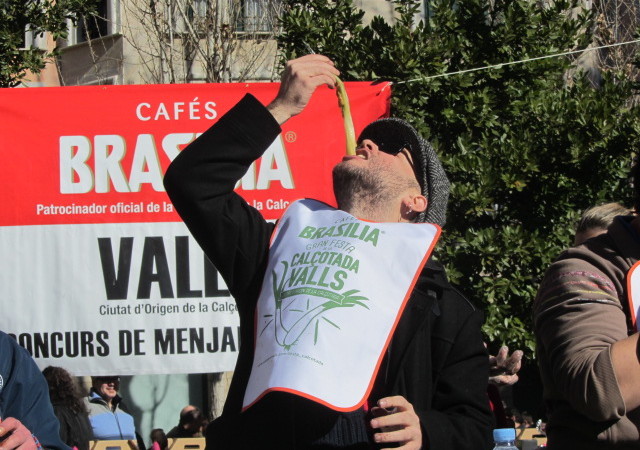During the coldest time of the year, towards the end of January and early spring, Catalans all over region begin to get excited about onions. Not just any onions though, this is a large sweet spring onions, called a calçot. Calçots are in fact so popular at this time of year, they even have their own festival.
Every year the small sleepy town of Valls holds its annual Calçotada Festival, paying homage to the calçot everything that it’s associated with. The Calçotada Festival is typically held at the end of January/beginning of February. This year it took place on January 28th and here’s what we got up to.

In the freezing cold early morning light, the festival began with the barbecuing of hundreds of calçots over big fires, set up in one of the town squares. Dark smoke filled the plaza and the fragrant smell of onions began to drift through the town.
The next part of the day lead us to another square where farmers were competing to see who had grown this year’s best calçots, while others were mixing up bowls of romesco sauce to dip them in and enter them in their own competition. The fragrant reddish sauce is made from roasted almonds, hazelnuts, garlic, red peppers, tomatoes and olive oil, and is the only thing calçots should be eaten with.

Besides the grilling and the competitions, the streets and plazas were filled with stalls selling all kinds of local produce, from cheese to multicoloured olives, bright green calçot bread, butifarra sausages and bubbling Cava.
At midday, a parade started through the narrow cobbled streets, lead by a giant calçot, dancing its way to the tunes of piccolos and drums. Next came the gegants or the giants of Valls. Each district or even city barrio in Catalunya seems to have its own giants who come out and parade through the streets during various festivities. The giants of Valls were a stately king and queen, a calçot farmer and his wife, who was making the sauce, and a collection of odd-looking peasants and jesters.

The parade ended in the town’s main plaza, where the highlight of the festival was to take place – the famous calçot eating competition, where 15 of the town’s best calçot-eaters lined up to compete. Complete with bibs, romesco sauce, glass jars of wine and mountains of calçots, the much-anticipated competition began. One by one the competitors dipped their calçots into the sauce and, held their heads up high and lowered them into their mouths, their hands getting blacker and blacker from the charcoaled outer layers and their bibs getting redder and redder from the sauce. The event seemed to carry on for a very long time, until finally a winner was declared, after eating just over two kilos of them.

During the last part of the festival, it was time for us to try our own calçots. For nine Euros each we bought a big bag filled with 12 steaming calçots, a tub of romesco dipping sauce, a bottle of red wine, some bread and an orange, and lined up at one of the long tables set out in the town squares. The atmosphere was jovial as locals and visitors of all ages set about having lunch together, laughing as the sauce dribbled down our faces and bigs, and our hands became as black as soot. The calçots themselves were definitely worth all the hype – sweet like leeks, but softer and flavoured with a hint of smoke and nutty pepper sauce.
After your visit here, you’ll never be able to look at a spring onion the same way again!






